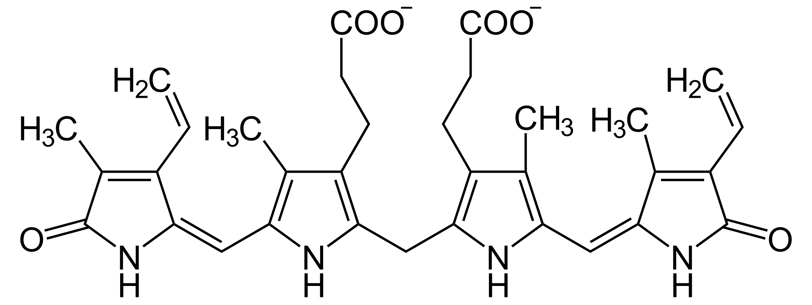Crigler-Najjar Syndrome: Unveiling the Rare Liver Disorder
Crigler-Najjar Syndrome (CNS) is a rare genetic liver disorder that disrupts bilirubin metabolism, leading to severe jaundice. It’s a condition that may sound unfamiliar to many, but for those affected, it’s a life-altering diagnosis. This article explores everything you need to know about Crigler-Najjar Syndrome, from its causes to its management.
GENETIC
Rishwin A R
1/5/20252 min read


Structure of bilirubin
What is Crigler-Najjar Syndrome?
Crigler-Najjar Syndrome is an autosomal recessive genetic condition characterized by the inability of the liver to process bilirubin, a byproduct of red blood cell breakdown. This results in an excessive build-up of unconjugated bilirubin in the blood, causing yellowing of the skin and eyes (jaundice).
Types of Crigler-Najjar Syndrome
CNS is classified into two types based on the severity:
Type 1 (Severe):
Complete absence of the enzyme glucuronosyltransferase (UGT1A1), crucial for bilirubin processing.
Symptoms appear shortly after birth and can be life-threatening if untreated.
Type 2 (Mild):
Partial deficiency of UGT1A1 enzyme.
Jaundice is less severe and often manageable with treatment.\
Causes
Crigler-Najjar Syndrome is caused by mutations in the UGT1A1 gene responsible for producing the enzyme that conjugates bilirubin. These mutations prevent the enzyme’s production (Type 1) or significantly reduce its activity (Type 2).
Symptoms
Persistent jaundice (yellowing of skin and eyes)
High levels of unconjugated bilirubin in the blood
Neurological complications in severe cases due to bilirubin deposition in the brain (kernicterus)
Distinguishing Features of Type 1 and Type 2:
Type 1: Severe jaundice appearing within the first few days of life, potential for kernicterus.
Type 2: Milder jaundice, typically developing later in childhood or adolescence.
Diagnosis
Accurate diagnosis is crucial to manage CNS effectively.
Medical History and Physical Examination:
Family history of jaundice or liver disorders.
Examination of skin and eye coloration.
Laboratory Tests:
Elevated levels of unconjugated bilirubin.
Normal liver enzyme levels to rule out other liver diseases.
Genetic Testing:
Identification of mutations in the UGT1A1 gene.
Liver Biopsy (Rarely Needed):
Used to confirm the absence or deficiency of UGT1A1 enzyme activity.
Treatment
Management of Type 1 CNS:
Phototherapy:
Blue-light therapy to reduce bilirubin levels.
Often required for extended periods or lifelong.
Liver Transplantation:
The only definitive cure for Type 1.
Recommended in severe cases where phototherapy is insufficient.
Management of Type 2 CNS:
Phenobarbital:
Medication to enhance residual UGT1A1 enzyme activity.
Reduces bilirubin levels effectively in most patients.
Lifestyle Adjustments:
Avoiding triggers such as certain drugs or stressors that may exacerbate jaundice.
Prognosis
The prognosis of CNS varies depending on the type:
Type 1: Without treatment, it can lead to severe neurological damage or death. However, with proper management, many patients live relatively healthy lives.
Type 2: Generally has a better prognosis and can often be managed effectively with medication.
FAQs About Crigler-Najjar Syndrome
1. Is Crigler-Najjar Syndrome curable?
Type 1 CNS can only be cured through a liver transplant. Type 2 is manageable with medication.
2. Can CNS be detected before birth?
Yes, prenatal genetic testing can identify mutations in the UGT1A1 gene.
3. How common is Crigler-Najjar Syndrome?
It is extremely rare, affecting fewer than 1 in 1,000,000 people globally.
4. What complications can arise from untreated CNS?
High bilirubin levels can lead to kernicterus, a condition causing irreversible brain damage.
5. Is phototherapy safe for long-term use?
Yes, but prolonged use may have side effects, such as skin damage or disruption of daily routines.
Conclusion
Crigler-Najjar Syndrome, while rare, is a serious condition requiring early diagnosis and effective management. Understanding the disorder can help patients and families navigate its challenges more confidently. With advancements in medical science, individuals with CNS have hope for improved quality of life and long-term outcomes.
Syndromes.xyz
Explore medical syndromes and their details here.
For Educational purposes only
The information on this site is not in any way, replacement for professional advice. Always consult your physician regarding personal queries
Connect
Support
syndromesxyz@gmail.com
© 2024. All rights reserved.
